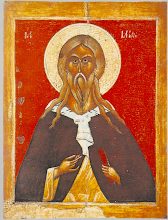The crisis that continues to shake the Church and to burden the hearts of priests with sorrow and uncertainty, requires a powerful spiritual antidote. Our Lord is calling His priests to tarry in His presence. He invites them to abide in the radiance of His Eucharistic Face, close to His Heart. There they will recover the joy of their youth and the certainty of being loved by Christ with an everlasting love.
Eucharistic adoration is a wellspring of priestly happiness. It is by daily adoration that the priest begins to say, in all truth, with the psalmist: “To be near God is my happiness” (Psalm 72:28) and, “My happiness lies in Thee alone” (Psalm 15:2). There is a correlation between happiness and holiness. A priest faithful to his daily hour of adoration will, like Saint John the Baptist, be a friend of the Bridegroom, “rejoicing with joy” (John 3:29) because of the Bridegroom’s voice, and capable of winning souls for Christ.
The centrality of the Eucharist should be apparent not only in the worthy celebration of the Sacrifice, but also in the proper adoration of the Sacrament, so that the priest might be the model for the faithful also in devote attention and diligent meditation — whenever possible — done in the presence of our Lord in the tabernacle. It is hoped that the priests entrusted with the guidance of communities dedicate long periods of time for communal adoration and reserve the greatest attention and honour for the Most Blessed Sacrament of the altar, also outside of Holy Mass, over any other rite or gesture. “Faith and love for the Eucharist will not allow Christ to remain alone in his presence in the tabernacle”. (Congregation for the Clergy, Directory on the Ministry and Life of Priests, 31 January 1994)The 19th and early 20th centuries saw, in fact, the birth of a number of movements for the promotion of Eucharistic adoration, reparation, and priestly holiness. The best known of these is, without doubt, the Association of Priest-Adorers of the Blessed Sacrament, founded by Saint Peter Julian, and canonically erected in Rome on 16 June 1887.
The second half of the last century saw many of these fine movements fall into decline, leaving a void in the spiritual life of new generations of priests. The Year of the Eucharist proclaimed by Saint John Paul II in 2004, and the Year of the Priesthood proclaimed by Pope Benedict XVI in 2009 were an invitation to rediscover and refresh the benefits that accrue to priests who commit themselves to prayer for and with one another, and in particular, to Eucharistic adoration.
In his Encyclical Letter of Holy Thursday, 17 April 2003, Ecclesia de Eucharistia, Saint John Paul II drew the eyes of the Church to the Face of Christ in the Most Holy Eucharist. He coined a new phrase, one not encountered before in his writings or in the teachings of his predecessors, “the Eucharistic Face of Christ.” Thus did Saint John Paul II share with the Church his own experience of seeking, finding, and adoring the Face of Christ in the Most Holy Sacrament of the Altar. The human face is a mysterious icon of the heart. It signifies, among other things, a personal presence open to relationship with another. In the Sacrament of His Love, the Face of Christ, the Human Face of God, is turned towards those who seek Him, ready to draw them into a healing and life-giving communion of love with His Sacred Heart. (Read more.)
Thursday, August 30, 2018
The Confraternity of Priest Adorers of the Eucharistic Face of Jesus
From Fr. Mark:
Sunday, August 12, 2018
The Current Crisis in the Catholic Church
From Fr. Heilman:
On October 7, 2017, over one million Catholics in Poland rose up and grabbed their rosaries and, mainly on their borders, called out to God with the powerful intercession of Our Lady....This was a grassroots effort that was, in essence, saying, “The demonic secular forces of this world are not welcome on our soil!” While not immune to the infiltration of modernism in Poland’s Catholic Church, they remain one of the strongest on the planet. In St. Faustina’s diary, she relates how our Lord told her,
“I bear a special love for Poland, and if she will be obedient to My will, I will exalt her in might and holiness. From her will come forth the spark that will prepare the world for My final coming” (Diary, 1732)Inspired by Poland — Ireland, the British Isles and Australia followed suit in praying for their respective countries with rosaries in hand (all “grassroots” efforts of the laity). The United States has been praying this way since 2016 (and the lead up to the Presidential election), with Novena for Our Nation, with over 40,000 USA Catholics praying the miraculous 54 Day Rosary Novena from August 15 (Feast of the Assumption) to October 7 (Our Lady of the Rosary). With the inspiration of Poland, we (USA) have reframed the concluding October 7 prayer campaign with the new title of “Rosary Coast to Coast” (Go to rosarycoasttocoast.com). Now, many nations have accepted the clarion call, and will be praying together on October 7, 2018 in what we now call the “Holy League of Nations” (Go to holyleagueofnations.com).
In the lead up to our launch of this 2018 enormous “Rosary Coast to Coast” nation-wide (now worldwide) prayer campaign (We launched on March 31, 2018), our planning team sought the support of all of the USA bishops. I warned the team that we would not get many to respond, much less support. And, as I predicted, only a handful responded and what support we received was timid (barring a few, including my own Bishop Morlino, Bishop Conley and Cardinal Burke). Why did I accurately predict this? Because I knew full well the “condition of our prelates in America.” I knew we would be received as more “dangerous” than “beneficial” to the Church in America. Why? Let me explain …
There was one reply, in particular, that still rings (stings) in my mind and heart, nearly on a daily basis, that, sadly, truly expressed this “condition of our prelates.” It came from a very prominent prelate who will remain nameless. Here was his reply …
“Father, I’m not fond of these national campaigns. I don’t know that they accomplish a whole lot and because of that, I just haven’t been willing to offer endorsements.”Yes, you read that correctly. Tens of thousands of people joined together in prayer to call out to God, through the powerful intercession of our Lady, to protect and heal our nation does not “accomplish a whole lot.” St. Louis de Montfort once wrote:
“When people say the Rosary together, it is far more formidable to the devil, than one said privately. Because in this public prayer, it is an army that is attacking him. He can often overcome the prayer of an individual, but if this prayer is joined to other Christians, the devil has much more trouble in getting the best of it.” -St Louis de Montfort.You see? This is the “problem” … this is the “condition” of the vast majority of our prelates. To them, St. Louis de Montfort and all of those crazy saints were just that … “crazy.” You see? WE have arrived on the scene and, thank God, WE are here now to take the “crazy” out of Catholicism. No more of this silly hocus pocus superstitious nonsense, under our watch. No more of this ridiculous belief in the supernatural power of God and the power of prayer, as long as we are here. In fact, those who advocate “the supernatural” are to be considered “dangerous” in our Church. Also, anyone who would actually defend the teachings of the Church is to be considered “dangerous.”
(Read more.)
Subscribe to:
Comments (Atom)





















